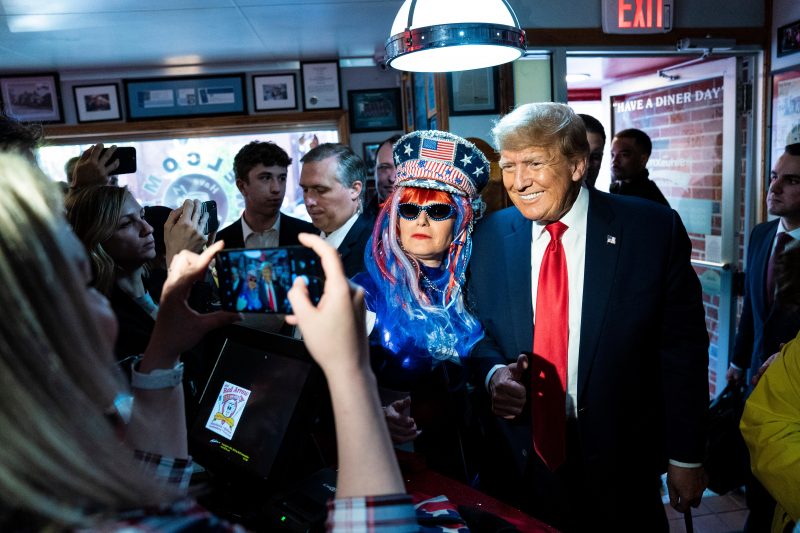When Donald Trump announced his first presidential bid in June 2015, he shrugged at the idea of doing a lot of fundraising. He was a billionaire, after all, and that was a central part of his pitch to voters. What, he was going to make regular Joes send him money just to run? No, he was going to disrupt the established way of doing things from the roots up.
In short order, of course, he realized that many people were willing to give him money anyway. You can imagine a theoretical moment in which Trump was torn between his stated position about receiving donations and his having achieved his lifelong goal of having people give him money just because of his name. In reality, there was almost certainly no such moment of moral uncertainty, and by the time he won the presidency in 2016, he had fully committed himself to figuring out how to get as much money from people as possible. Even after he lost the presidency in 2020, he kept up the hustle.
The result is that, while the early months of his 2016 bid were driven largely by his own money, the picture to date in his 2024 bid has been different. Now, he’s running on someone else’s dime, and a review of his campaign filings reveals that the majority of contributions to his campaign come from retirees.
You may be aware that at the lower end of the contribution spectrum, the process of reporting donations is a bit flaky. If you buy a hat at a campaign rally, that’s technically a contribution. Unless that hat cost at least $50, though, the campaign doesn’t need to record any of your personal information; the amount is too small to trigger those reporting requirements.
Give at least $50 and the campaign records your name, address, employer and occupation. The point is to be able to track how much people are giving, so that if a columnist for The Washington Post gives $1,000 to Trump on one day and $3,000 on another day, the Federal Election Commission can figure out that this person exceeded the $3,300 contribution limit. The campaign would need to return $700 to that columnist — useful money, since the person would very quickly have been fired by Thpe Post.
When you contribute online, the same information is collected. That means that a lot of contributions (again, such as buying hats) trigger the gathering of data on employment that otherwise would be lost. It also means that you get some people who don’t entirely take things seriously. Is there really someone named “Ima Fortrump” who contributed to his campaign? Is Trump donor Michael Wilson actually an “assassin” employed by the federal government? Here’s hoping not.
By aggregating the contributions for each identified job, we get an interesting picture of how Trump’s early financial support has changed over the past eight years. In the first two quarters of his 2016 bid, nearly 75 percent of what Trump raised was contributed by Trump himself. In the first three quarters of his current bid, he has raised more than five times as much, without a dime coming directly from his own bank account.
Instead, more than half of the $23 million-plus he’s raised has come from people who identify their occupation as “retired.” Other titles of people who gave the most contributions in aggregate include “attorney,” “CEO,” “sales” and “home maker.”
It’s not surprising that plain, unadorned job titles — “engineer,” “physician” — have given the most money cumulatively, since those are going to be more common. There are a lot of contributions from individuals who list their occupations as variants of similar things, like “VP” vs. “vice president” vs. “VP Marketing.” Each of those would land as a separate “occupation” despite the obvious similarity in the job title.
It’s also not necessarily surprising that “retired” lands so high on the list. Since Trump’s 2016 campaign, online contributions have surged, thanks in part to the emergence of the fundraising site WinRed. If you go to Trump’s contribution page, itself hosted by WinRed, you are prompted to enter your occupation information. There’s also a big checkbox reading “I’m retired.” Click that before making your contribution and you’re logged as “retired” — without any weird misspellings (e.g., “reetired”) or alternative explanations (like “retiree”).
Still, that more than half of Trump’s individual contributions come from self-described retirees is remarkable. It’s not surprising, certainly; the Republican Party skews older than the Democratic Party. But it’s remarkable.
It’s also noteworthy that the average contributions from those retirees is relatively small, landing under $50. This suggests that the donations (which might include multiple contributions of less than $50 from one person) were made online, as most donations are these days. The group that gave the most in aggregate with the highest average contribution? Those who didn’t provide their employment information to the campaign. (They will need to do so.)
You may also recall that, after the 2020 election, Trump’s campaign came under scrutiny for its use of opt-out recurring contributions. There’s still the option to make donations recurring, but it’s now opt-in.
It is expensive to run for president, as Trump knows well. He no longer spends much time, if any, pretending that he doesn’t need individual contributions. Nor does he talk about how much he’s willing to spend on his candidacy. He did so in 2015 in part because no one really believed he was going to stick around — something about which people are no longer uncertain.
There is another reason he might be less willing to try to self-finance this time around. In 2015, he was estimated to be worth $4.5 billion. The estimate now is $2.5 billion. Looks like the retirees will need to make up the shortfall.

